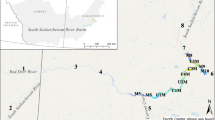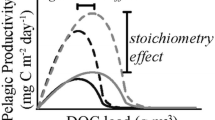Abstract
We compared regression tree analyses and multiple linear regression models to explore the relative importance of physical factors, land use, and water quality in predicting phytoplankton production and N2 fixation potentials at 85 locations along riverine to lacustrine gradients within eight southern reservoirs. The regression tree model (r 2 = 0.73) revealed that differences in phytoplankton production were primarily a function of water depth. The highest rates of production (mg C m−3 h−1) occurred at shallow sites (<0.9 m), where rates were also related to total phosphorus (TP) levels. At deeper sites, production rates were higher at sites with relative drainage area (RDA, ratio of drainage area to water surface area) below 45, potentially due to longer hydraulic residence times. In contrast, multiple linear regression selected TP, RDA, dissolved phosphorus, and percent developed land as significant model variables (r 2 = 0.63). The regression tree model (r 2 = 0.67) revealed that N2 fixation potentials (mg N m−3 h−1) were substantially higher at sites with relatively smaller drainage areas (RDA < 45). Within this subgroup, fixation rates were additionally related to TP values (threshold = 41 μg l−1). The multiple linear regression model (r 2 = 0.67) also selected RDA as the primary predictor of N2 fixation. Regression tree models suggest that nutrient controls (phosphorus) were subordinate to physical factors such as depth and RDA. We concluded that regression tree analysis was well suited to revealing nonlinear trends in data (for example, depth), but yielded large uncertainty estimates when applied to linear data (for example, phosphorus).






Similar content being viewed by others
References
Adamus PR, Stockwell CT. 1983. A method for wetland function assessment, volume I: critical view and evaluation concepts. United States Federal Highway Administration, FHWA-IP-82-23
Arbuckle KE, Downing JA. 2001. The influence of watershed land use on lake N:P in a predominantly agricultural landscape. Limnol Oceanogr 46: 970–5
Arhonditsis GB, Stow CA, Paerl HW, Valdes-Weaver LM, Steinberg LJ, Reckhow KH. 2007. Delineation of the role of nutrient dynamics and hydrologic forcing on phytoplankton patterns along a freshwater–marine continuum. Ecol Model 208: 230–46
Berman T. 2001. The role of DON and the effect of N:P ratios on occurrence of cyanobacterial blooms: implications from the outgrowth of Aphanizomenon in Lake Kinneret. Limnol Oceanogr 46: 443–7
Breiman L, Friedman JH, Olshen RA, Stone CJ. 1984. Classification and regression trees. Belmont (CA): Wadsworth International Group. 358 pp
Carpenter SR, Caraco NF, Correll DL, Howarth RW, Sharpley AN, Smith VH. 1998a. Nonpoint pollution of surface waters with phosphorus and nitrogen. Ecol Appl 8:559–68
Carpenter SR, Cole JJ, Hodgson JR, Kitchell MF, Pace ML, Bade D, Cottingham KL, Essington TE, Houser JN, Schindler DE. 2001. Trophic cascades, nutrients, and lake productivity: whole-lake experiments. Ecol Monogr 71:163–86
Carpenter SR, Cole JJ, Kitchell JF, Pace ML. 1998b. Impact of dissolved organic carbon, phosphorus and grazing on phytoplankton biomass and production in experimental lakes. Limnol Oceanogr 43: 73–80
Cuevas JG, Soto D, Arismendi I, Pino M, Lara A, Oyarzún C. 2006. Relating land cover to stream properties in southern Chilean watersheds: trade-off between geographic scale, sample size, and explicative power. Biogeochemistry 81: 313–29
De’Ath G, Fabricius KE. 2000. Classification and regression trees: a powerful yet simple technique for ecological data analysis. Ecology 81: 3178–92
Dickman M. 1969. Some effects of lake renewal on phytoplankton productivity and species composition. Limnol Oceanogr 14: 660–6
Downing JA, McCauley E. 1992. The nitrogen:phosphorus relationship in lakes. Limnol Oceanogr 37: 936–45
Fee EJ. 1973. A numerical model for determining integral primary production and its application to Lake Michigan. J Fish Res Board Can 30: 1447–68
Flett RJ, Hamilton RD, Campbell NER. 1975. Aquatic acetylene-reduction techniques: solutions to several problems. Can J Microbiol 22:43–51
Gilbert MC, Whited PM, Clairain EJ, Jr, Smith RD. 2006. A regional guidebook for applying the hydrogeomorphic approach to assessing wetland functions of prairie potholes. ERDC/EL TR-06-5
Goldman CR, Horne AJ. 1983. Limnology. McGraw-Hill, New York, USA
Gordon JA, Behel RM. 1985. Suspended sediment characteristics of Lake Cumberland, Kentucky. In: Proceedings North American Lake Management Society, 1984. p 259–64
Grobbelaar JU. 1989. The contribution of phytoplankton productivity in turbid freshwaters to their trophic status. Hydrobiologia 173: 127–33
Harmel RD, Richardson CW, King KW, Allen PM. 2006. Runoff and soil loss relationships for the Texas Blackland Prairies ecoregion. J Hydrol 331:471–83
Horne AJ, Commins ML. 1987. Macronutrient controls on nitrogen fixation in planktonic cyanobacterial populations. N Z J Marine Freshw Res 21:413–23
Horppila J, Liljendahl-Nurminen A. 2005. Clay–turbidity interactions may not cascade—a reminder for lake managers. Restorat Ecol 13: 242–6
Howarth RW, Marino R, Lane J, Cole JJ. 1988a. Nitrogen fixation in freshwater, estuarine, and marine ecosystems. 1. Rates and importance. Limnol Oceanogr 33: 669–87
Howarth RW, Marino R, Cole JJ. 1988b. Nitrogen fixation in freshwater, estuarine, and marine ecosystems. 2. Biogeochemical controls. Limnol Oceanogr 33: 688–701
Huppert A, Blasius B, Stone L. 2002. A model of phytoplankton blooms. Am Nat 159: 156–71
Jones ID, Elliott JA. 2007. Modeling the effects of changing retention time on abundance and composition of phytoplankton species in a small lake. Freshw Biol 52: 988–97
Kennedy RH, Walker WW. 1990. Reservoir nutrient dynamics. In: Thornton K, Kimmel B, Payne F, Eds. Reservoir limnology: ecological perspectives. New York: Wiley & Sons. p 109–32
Kimmel BL, Lind OT, Paulson LJ. (1990). Reservoir primary production. In: Thornton K, Kimmel B, Payne F, Eds. Reservoir limnology: ecological perspectives. New York: Wiley & Sons. p 133–94
King RS, Deluca WV, Whigham DF, Marra PP. 2007. Threshold effects of coastal urbanization on Phragmites australis (common reed) abundance and foliar N in Chesapeake Bay. Estuaries Coast 30:469–81
King RS, Hines AH, Craige FD, Grap S. 2005a. Regional, watershed and local correlates of blue crab and bivalve abundances in subestuaries of Chesapeake Bay, USA. J Exp Marine Biol Ecol 312: 101–16
King RS, Baker ME, Whigham DF, Weller DE, Jordan TE, Kazyak PF, Hurd MK. 2005b. Spatial considerations for linking watershed land cover to ecological indicators in streams. Ecol Appl 15:137–53
Levine SN, Lewis Jr WM. 1987. A numerical model of nitrogen fixation and its application to Lake Valencia, Venezuela. Freshw Biol 17:265–74
Lewis RJ. 2000. An Introduction to classification and regression tree (CART) analysis. In: Presented at the 2000 annual meeting of the Society for Academic Emergency Medicine in San Francisco, California
Lind OT, Doyle R, Vodopich DS, Trotter BG, Limón JG, Dávalos-Lind L. 1992. Clay turbidity: regulation of phytoplankton production in a large, nutrient-rich tropical lake. Limnol Oceanogr 37: 549–65
Maberly SC, King L, Dent MM, Jones RI, Gibson CE 2002. Nutrient limitation of phytoplankton and periphyton growth in upland lakes. Freshw Biol 47: 2136–52
McQueen DJ, Lean DRS 1987. Influence of water temperature and nitrogen to phosphorus ratios on the dominance of blue-green algae in Lake St. George, Ontario. Can J Fish Aquat Sci 44: 598–604
Nõges T, Laugaste R, Nõges P, Tõnno I. 2008. Critical N:P ratio for cyanobacteria and N2-fixing species in the large shallow temperate lakes Peipsi and Võrtsjärv, North-East Europe. Hydrobiologia 599: 77–86
Osidele OO, Beck MB. 2004. Food web modelling for investigating ecosystem behaviour in large reservoirs of the south-eastern United States: lessons from Lake Lanier, Georgia Ecol Model 173: 129–58
Paerl HW. 1985. Microzone formation: its role in the enhancement of aquatic N2 fixation. Limnol Oceanogr 30: 1246–52
Paerl HW, Webb KL, Baker J, Wiebe WJ. 1981. Nitrogen fixation in natural waters. In: Broughton, WJ, Ed. Nitrogen fixation, volume 1, Ecology. Oxford: Clarendon Press. p 193–240
Parr LB, Mason CF. 2004. Causes of low oxygen in a lowland, regulated eutrophic river in Eastern England. Sci Total Environ 321:273–86
Patoine A, Graham MD, Leavitt PR. 2006. Spatial variation of nitrogen fixation in lakes of the northern Great Plains. Limnol Oceanogr 51: 1665–77
Pickett JR, Harvey RM. 1988. Water quality gradients in the Santee-Cooper Lakes, South Carolina. Lake Reserv Manag 4: 11–20
Qian SS, King RS, Richardson CJ. 2003. Two statistical methods for the detection of environmental thresholds. Ecol Model 166: 87–97
Rejwan C, Collins NC, Brunner LJ, Shuter BJ, Ridgway MS. 1999. Tree regression analyses on the nesting habitat of smallmouth bass. Ecology 80: 341–8
Schindler DW. 1978. Factors regulating phytoplankton production and standing crop in the world’s freshwaters. Limnol Oceanogr 23: 148–486
Scott JT, Doyle RD, Prochnow S, White JD. 2008. Are watershed and lacustrine controls on planktonic N2 fixation hierarchically structured? Ecol Appl 18:805–19
Smayda TJ. 1970. The suspension and sinking of phytoplankton in the sea. Oceanogr Marine Biol Annl Rev 8: 353–414
Smith VH. 1983. Low nitrogen to phosphorus ratios favor dominance by blue–green algae in lake phytoplankton. Science 221:669–671
Smith VH. 1990. Nitrogen, phosphorus, and nitrogen fixation in lacustrine and estuarine ecosystems. Limnol Oceanogr 35:1852–59
Smith RK, Baker KS, Holm-Hansen O, Olson R. 1980. Photoinhibition of photosynthesis in natural waters. J Photochem Photobiol 31: 585–92
Smith VH, Shapiro J. 1981. Chlorophyll–phosphorus relations in individual lakes: their importance to lake restoration strategies. Environ Sci Technol 15:444–51
Søballe DM, Kimmel BL. 1987. A large-scale comparison of factors influencing phytoplankton abundance in rivers, lakes, and impoundments. Ecology 68:1943–54
Sterner RW. 1989. Resource competition during seasonal succession toward dominance by cyanobacteria. Ecology 10: 229–45
Sterner RW. 1994. Seasonal and spatial patterns in macro- and micronutrient limitation in Joe Pool Lake, Texas. Limnol Oceanogr 39: 535–50
Thomas DB, Schallenberg M. 2007. Benthic shear stress gradient defines three mutually exclusive modes of non-biological internal nutrient loading in shallow lakes. Hydrobiologia 610:1–11
Thornton KW. 1990. Perspectives on reservoir limnology. Thornton K, Kimmel B, Payne F, Eds. In Reservoir limnology: ecological perspectives, Wiley and Sons, New York. 1–14
Thornton KW, Kennedy RH, Carroll JH, Walker WW, Gunkel RC, Ashby S. 1981. Reservoir sedimentation and water quality—an heuristic model. In: Stefan HG, Ed. Proceedings of the symposium on surface water impoundments. New York (NY): American Society of Civil Engineers
Thornton KW, Kimmel BL, Payne FE, Eds. 1990. Reservoir limnology: ecological perspectives. Wiley & Sons, Inc. 245 pp
Urban DL. 2002. Classification and regression trees. In: McCune B, Grace JB, Eds. Analysis of ecological communities. Oregon: MjM Software Design. p 222–32
Vanderhoef LN, Huang C, Musil R, Williams J. 1974. Nitrogen fixation (acetylene reduction) by phytoplankton in Green Bay, Lake Michigan, in relation to nutrient concentrations. Limnol Oceanogr 19: 119–25
Vanni MJ, Andrew JS, Renwick WH, Gonzales MJ, Noble SJ. 2006. Nutrient and light limitation of reservoir phytoplankton in relation to storm-mediated pulses in stream discharge. Arch. Hydrobiol. WL37: 1–25
Venables WN, Ripley BD. 1994. Modern applied statistics with S-plus. Springer, New York. 501 p
Vollenveider RA, Kerekes JJ. 1980. Background and summary results of the OECD Cooperative Program on Monitoring of Inland Waters (Eutrophication Control). p 290
Wetzel RG. 1983. Limnology, 2nd ed. Saunders College Publishing, Orlando, FL. 756 p
Weibel SR. 1969. Urban drainage as a factor in eutrophication. Eutrophication: causes, consequences, correctives. National Academy of Sciences, Washington, DC, 383–403
Zevenboom W, Mur LR. 1980. N2-fixing cyanobacteria: why they do not become dominant in Dutch, hypertrophic lakes. In: Barica J, Mur LR, Eds. Hypertrophic ecosystems. The Hague, Netherlands: Dr. W. bv Junk Publishing. p 123–30
Acknowledgments
This study was supported by grants from the U.S. Environmental Protection Agency through the Texas Commission on Environmental Quality and Brazos River Authority. The authors thank Jason Taylor and Ryan King for discussions regarding CART analysis. Barry Fulton and Theodore Valenti, Jr provided assistance with data collection. Kirk Dean, Shane Prochnow, and Matt Schreiner supported land use analysis. Ken Wagner and Larry Koenig provided useful comments. Additional support was provided for M.G. Forbes through the Baylor University post-doctoral fellowship program.
Author information
Authors and Affiliations
Corresponding author
Rights and permissions
About this article
Cite this article
Forbes, M.G., Doyle, R.D., Scott, J.T. et al. Physical Factors Control Phytoplankton Production and Nitrogen Fixation in Eight Texas Reservoirs. Ecosystems 11, 1181–1197 (2008). https://doi.org/10.1007/s10021-008-9188-2
Received:
Revised:
Accepted:
Published:
Issue Date:
DOI: https://doi.org/10.1007/s10021-008-9188-2




